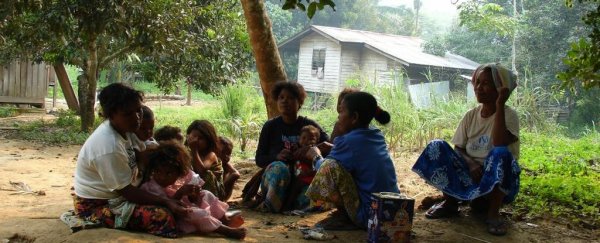A village in the northern Malay Peninsula has been known to anthropologists for some time, but linguists have just figured out that these settled hunter-gatherers use their very own, previously undocumented language.
Comprising just 280 people, the villagers speak an Aslian language newly named Jedek by linguists at Lund University in Sweden.
"Jedek is not a language spoken by an unknown tribe in the jungle, as you would perhaps imagine, but in a village previously studied by anthropologists," said Lund's Niclas Burenhult, who collected the first Jedek linguistic material.
"As linguists, we had a different set of questions and found something that the anthropologists missed."
Aslian languages are spoken by around 14 small groups of Orang Asli, or aboriginal people, around the Malay Peninsula, totalling around an estimated 50,000 speakers in all. The languages are interlinked through a lot of similarities, yet still genuinely distinct.
But they're also edging towards extinction, as younger generations switch over to Malay.
The Lund researchers were in the region documenting languages as part of the Tongues of the Semang project launched in 2005, an attempt to preserve the endangered indigenous languages and traditions of the Malay Peninsula.
Jedek was discovered as the team were studying the Jahai language.
"We realised that a large part of the village spoke a different language," researcher Joanne Yager explained.
"They used words, phonemes and grammatical structures that are not used in Jahai. Some of these words suggested a link with other Aslian languages spoken far away in other parts of the Malay Peninsula."
Speakers of Jahai and another nearby language, Menriq, are aware of the linguistic difference, calling the speakers of the third language Jdɛk. Sometimes Jedek speakers used the word themselves, so all this led to the name Jedek being used.
Jedek speakers are highly multilingual, usually able to speak Jahai, and cohabiting and intermarrying with Jahai speakers. This is fairly common among the Semang Orang Asli, which are highly mobile and come into frequent contact with surrounding communities.
Most Semang, the researchers noted, can speak at least three languages fluently - two Aslian languages, and either Malay or Thai.
The community has almost no interpersonal violence, they actively encourage their children not to compete, and there are no courts or laws, the researchers said.
There are also no strict gender divisions or professions, with everyone learning a gamut of skills required for the hunter-gatherer community.
All these characteristics are reflected in the language, with no words for professions or laws or ownership. Instead, there is a rich vocabulary to describe exchange and sharing.
"There are so many ways to be human, but all too often our own modern and mainly urban societies are used as the yardstick for what is universally human," Burenhult said.
"We have so much to learn, not least about ourselves, from the largely undocumented and endangered linguistic and cultural riches that are out there."
There are an estimated 6,000 languages spoken in the world today, with 3,600 of those smaller languages spoken by just 20 percent of the population.
According to a 2015 UNESCO report, half of the world's languages could be extinct by the end of the century if nothing is done to preserve them.
Because the pool of Jedek speakers is so small, the language is officially considered endangered, but that doesn't mean it is in danger of dying out.
The paper notes that the Jedek group has likely always been small; and that it's likely that it was smaller 40 years ago, based on recent estimates.
It's also spoken by all generations, and understood by all residents of the region, including the Jahai.
"Jedek is endangered and vulnerable to influence in a variety of different ways. But this does not necessarily spell imminent extinction for the variety," the researchers wrote in their paper.
The study has been published in the journal Linguistic Typology.
